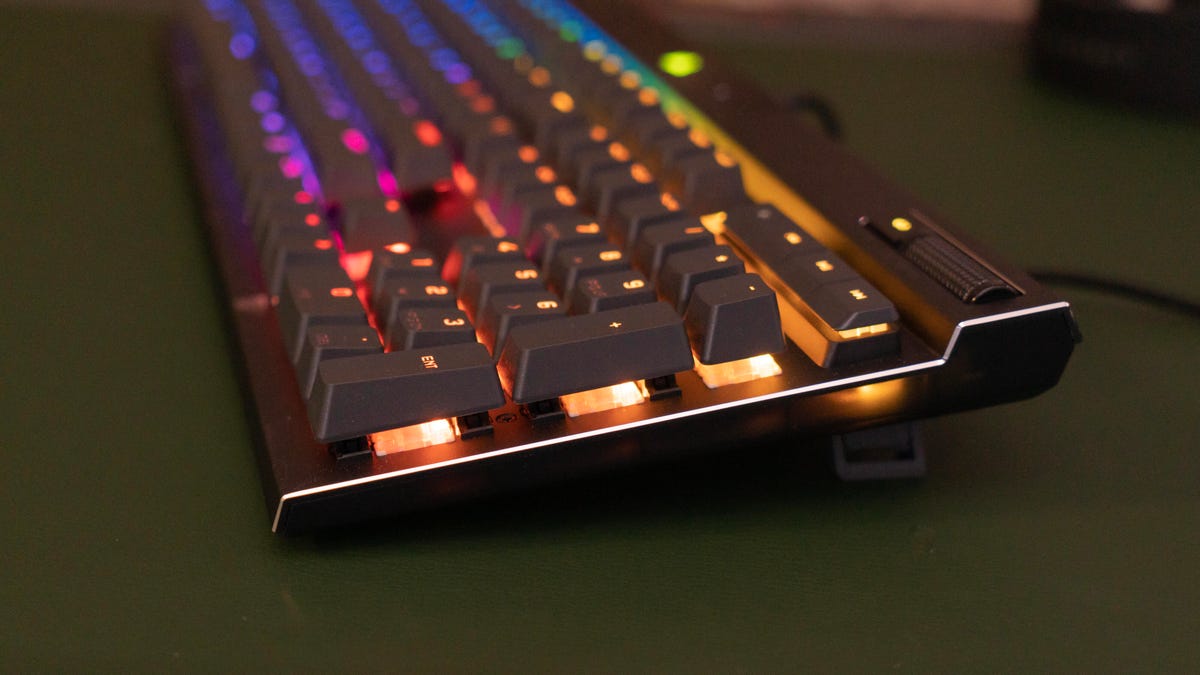Corsair’s top-of-the-line model in its K70 series of gaming keyboards, the K70 Max ($230, 249 or roughly AU$485), delivers a lot for its high price if you’re willing to take advantage of the type of customization it offers. Unlike the K70 Pro, which has traditional optical switches offered in linear, clicky and tactile variants, the Max comes with magnetic-mechanical MGX switches, comprised of a magnet which controls the point at which a keystroke registers (actuation point) lodged inside a spring that makes it feel more mechanical.
The technology enables useful capabilities, like the ability to manually define actuation points — two per key in the range of 0.4-3.6mm, for things like quick combos — and reset points. I found the dual actuation useful for double jumps, for instance. But the feel of the keys is idiosyncratic compared to more conventional mechanical and optical switches, thanks to a combination of the magnetic actuator, soft landing and full 4mm travel. The effect is like jumping from a plane and landing on a steel core wrapped in a layer of air inside a marshmallow. It’s an acquired taste that I’ve had some trouble acquiring.
For example, linear switches essentially have no actuation distance, or one that’s so small it might as well as be none. But the equivalent setting on the MGX switches (0.4mm) still feels like there’s a slight but distinct point to overcome through. So they don’t feel quite as smoothly linear as optical switches, though there isn’t enough resistance to prevent accidental presses because it has the same light 45g actuation force of opticals like Razer’s.
But your mileage may vary, because different hands and brains.
There are compelling reasons to put up with the oddness, though, if it doesn’t throw you off too badly. The customizable actuation and reset points let you find that exact point where you can execute a move as fast as possible without overshooting, rather than letting your keyboard dictate your response.
I had to go through a lot of trial and error to find a setting that made my spacebar sufficiently easy to actuate without repeating, for instance. I finally ended up with a midrange actuation point (2.1mm) and a short reset point (0.6mm); if you use spaces in hidden fields (like passwords), reliable keystrokes are critical, since you can’t tell if you’ve made a mistake.

You can also try using the dual actuation points to the same end, or change the global debounce delay setting, which is normally zero (a positive debounce adds a slight lag between the keypress and the registering of the keystroke). The dual actuations are nice, but for a lot of people it might not compensate for the lack of dedicated macro keys. I wish there were a built-in way to test different variations or presets with combinations of settings when you get started.
Since you probably don’t want the same settings while gaming, being able to add granular settings to profiles and load them into the keyboard’s memory is good. If you need to quickly “wipe” all the customizations, there’s a tournament mode switch.
Corsair plans to offer an update with support for Rapid Trigger mode, where the switch effectively resets immediately upon release. A firmware update is slated for the end of August, and it’ll be integrated into iCue, Corsair’s software for Mac, by the end of the year. The latter is necessary to customize it.
The keyboard works with consoles and the Mac as well as Windows, but iCue is a version behind Windows and doesn’t run at all on consoles. So the ability to cycle through profiles in hardware is key, though you may not be able to customize if you don’t have a Windows system. And in order to take advantage of its 8,000 Hz polling rate (or anything above 1K Hz, I believe), you need iCue.

Beyond the switches and what they bring to the table, the Pro Max is pretty much the same as the Pro. It’s tanklike and heavy, thanks to all the metal in it, with nice design touches including multiple channels to thread the braided cable through. There’s a nice magnetically connecting wrist rest with rubber tabs that cushion the bottom edge of the keyboard (and accumulate schmutz). There’s also bright, shine-through per-key RGB lighting and sturdy, textured doubleshot PBT keycaps.
The only thing I don’t like about the keys is the sound of the spacebar. It’s stable, with three points of attachment, but it sounds hollow and high-pitched. That’s not an issue if you wear a headset, but when it’s just you, your keyboard and your speedy touch typing, the noise kind of grates.
The Corsair K70 Max probably doesn’t have broad appeal; the price alone narrows the potential pool of buyers. And I’m not sure how practical it is generally. If speed matters to you, you may be better off with the speed and consistency of optical switches like the Corsair OPX versions in the cheaper K70 Pro, among other brands. But if you need a keyboard that can be many things to many games — and work, too — the K70 Max may offer the flexibility of a custom feel for every occasion.
